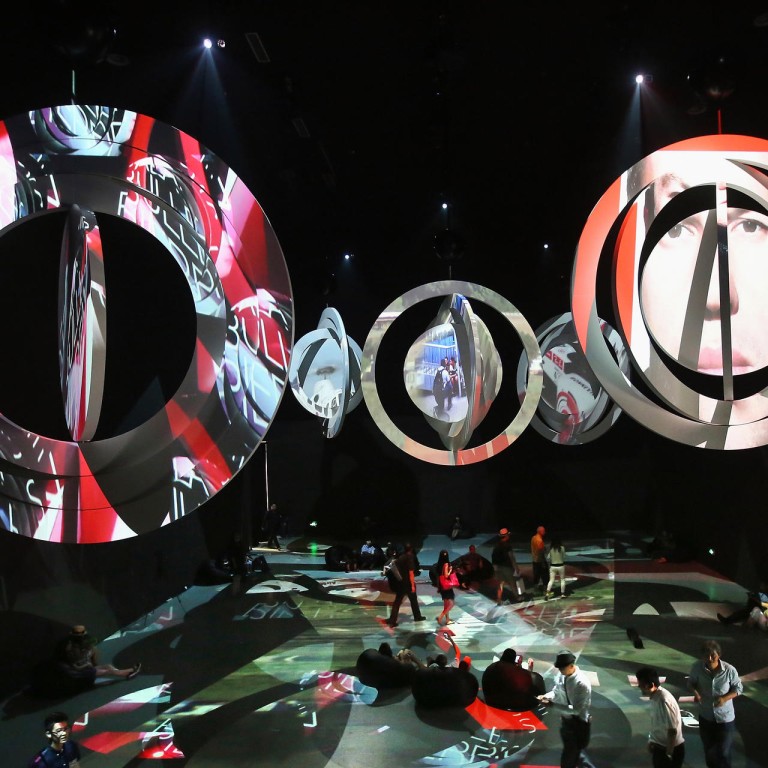
Visitor photos put different spin on exhibition in Beijing
Swiss photographer Hannes Schmid invites visitors to share the creative process by uploading their own photographs on to a series of enormous, revolving sculptural mobiles
Of the interactive art exhibitions happening in Beijing, the most interesting shows go beyond responding to an artist's work by offering visitors active participation in creating new art.
At the Today Art Museum, for instance, Swiss photographer Hannes Schmid invites visitors to share the creative process by uploading their own photographs on to a series of enormous, revolving sculptural mobiles suspended from the ceiling of one of its ground-floor galleries. "Momentous" is presented by UBS and runs until Thursday.
The interactive digital element is relatively new to Schmid, who is known for his advertising photography, but it is in keeping with his cultural investigation. Born in Zurich in 1946, Schmid's anthropological approach to photography includes a decade on tour with more than 250 rock bands including Queen and AC/DC. He is also behind the 1990s relaunch of the Marlboro Man imagery.
In 2002, Schmid produced a multimedia series investigating the themes of speed and time through the world of Formula 1 motor racing, famously dunking a multimillion-dollar race car in a swimming pool at Pierre Cardin's Bubble House on the French Cote d'Azur and photographing race driver Jenson Button swimming laps alongside it.
"We had been told the car would be a model without an engine but as soon as it was submerged we noticed oil seeping out," he says. "When the Formula 1 engineers came to collect the car and saw it at the bottom of the pool they really freaked out. The car was destroyed so I knew the photographs would have to be exceptional."
"Momentous" includes a selection of these iconic images and video installations with a series of Schmid's landscape studies documenting a trial run by BAR-Honda on the Salt Flats of Utah and unconventional portraits of Formula 1 drivers Jacques Villeneuve and Takuma Sato.
Although visually engaging, it is the interactive element of the exhibition that lifts it above a traditional mini-retrospective. Schmid says the idea to collaborate with visitors in Beijing came from an installation he created last year at Zurich airport where travellers used a QR code to upload images to turn the space into a three-dimensional virtual museum. Over the course of six weeks, more than 70 per cent of the 1.2 million people who interacted with the work were Asian.
"I was worried the interactive part of the exhibition would be a pitch to the Apple generation, but it feels genuine. It is simple but it feels like I'm really part of it," says an art student who visited on opening day.
Schmid says the ease of uploading images is critical: smart phones in the museum identify the exhibition's dedicated Wi-fi signal, and uploading an existing or new image takes the click of one button. A time is then given indicating when the image will appear.
A team of Swiss engineers constructed the mobiles which comprise four separate parts that turn at different speeds, never meeting to form a whole. Powerful but silent motors turn the mobiles in a precise pattern to capture the projected images and Schmid's video art. The effect is mesmerising, producing shadows that create an intriguing interaction between the image and immersive context.
With all eyes on the mobiles, it is easy to miss how the spectators become the spectacle or how images influence choice. By limiting how much of the image can be seen at one time, Schmid subtly encourages the participant to piece it together, subliminally altering our perception of the images.
Given the mainland's policy on its outspoken artists, the visitors' photographs arrive in a closed circle within a "traffic line", with time to delete the images if necessary. "It's the same arrangement in Europe. I can't allow pornography for example, and I'm happy with that arrangement," Schmid says. "My job here is not to criticise. It is to build a bridge of cultural understanding. This type of dialogue is very important. Sometimes art can achieve more than politics."

